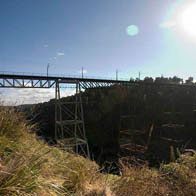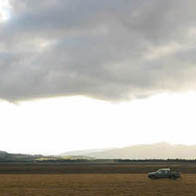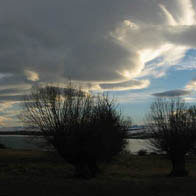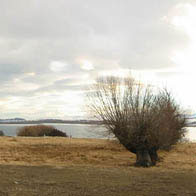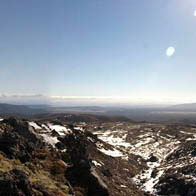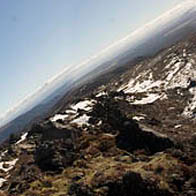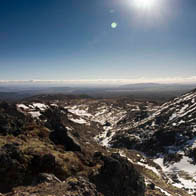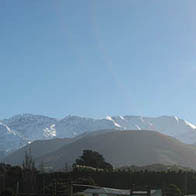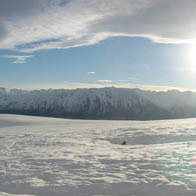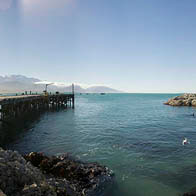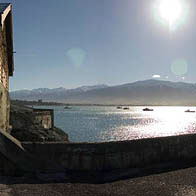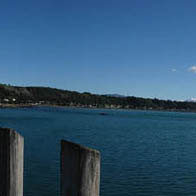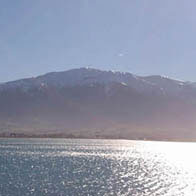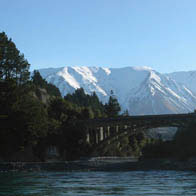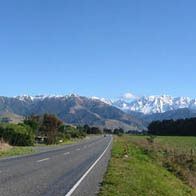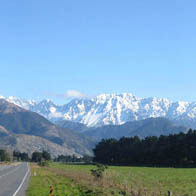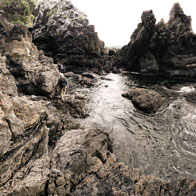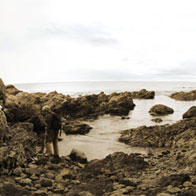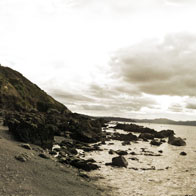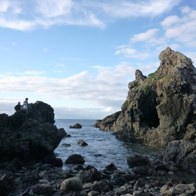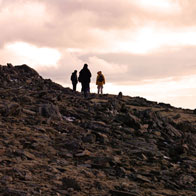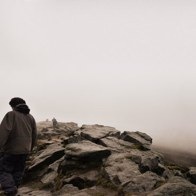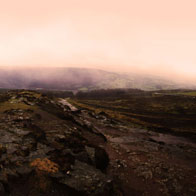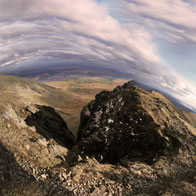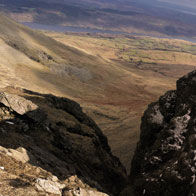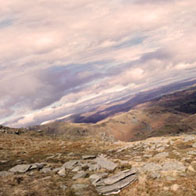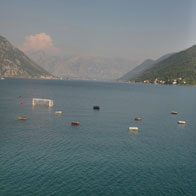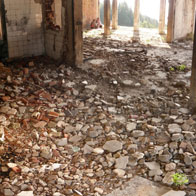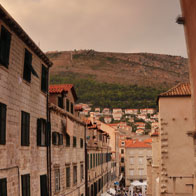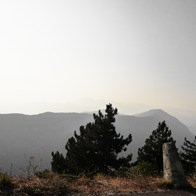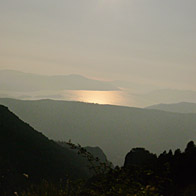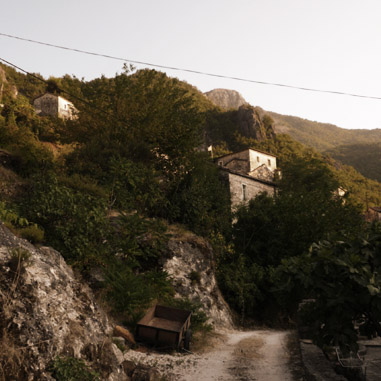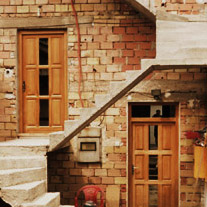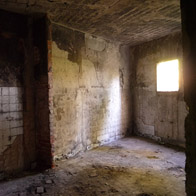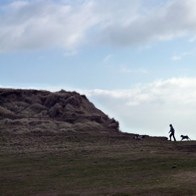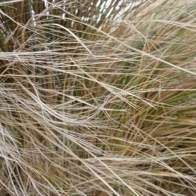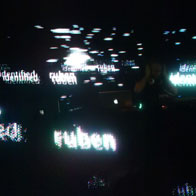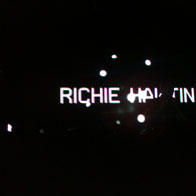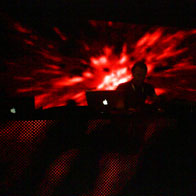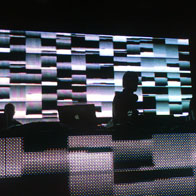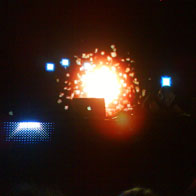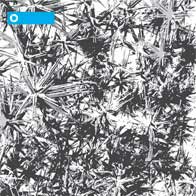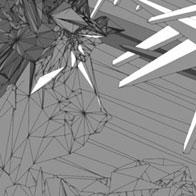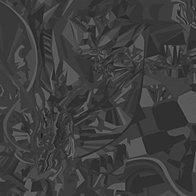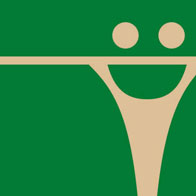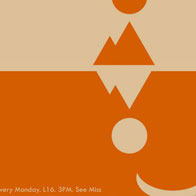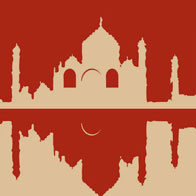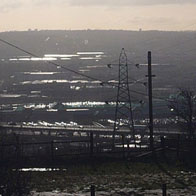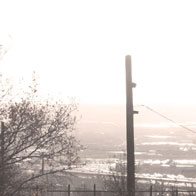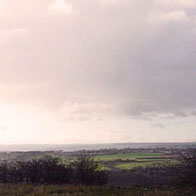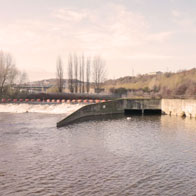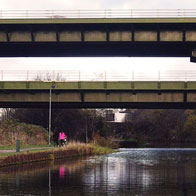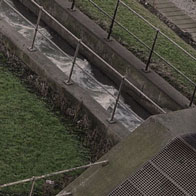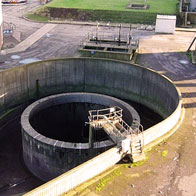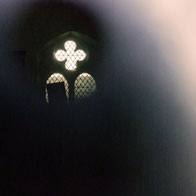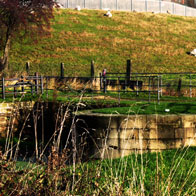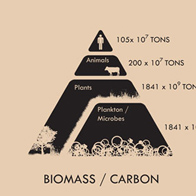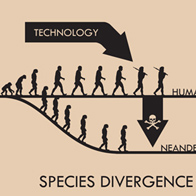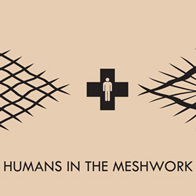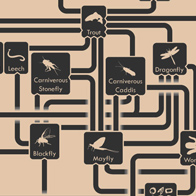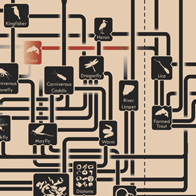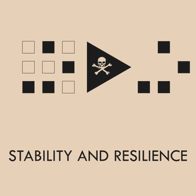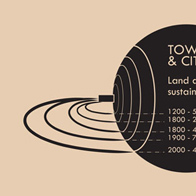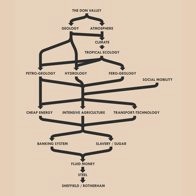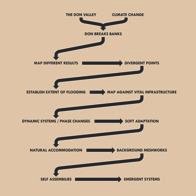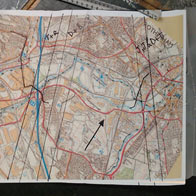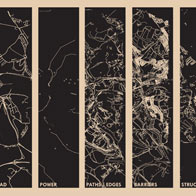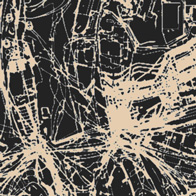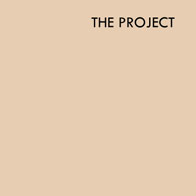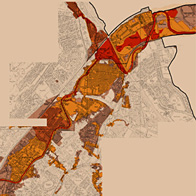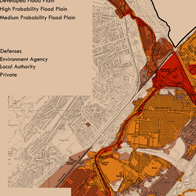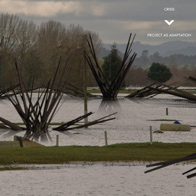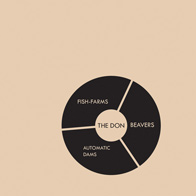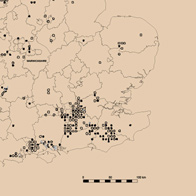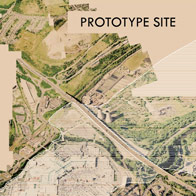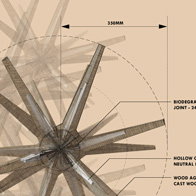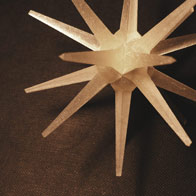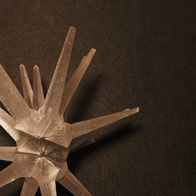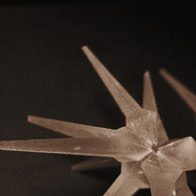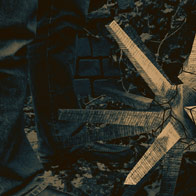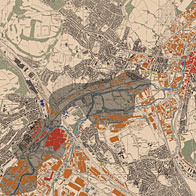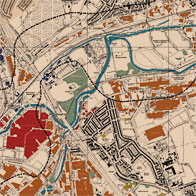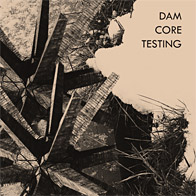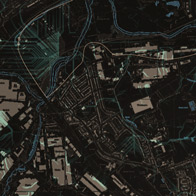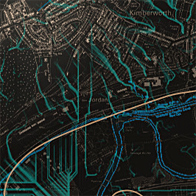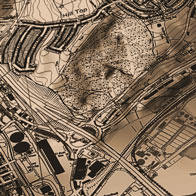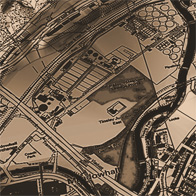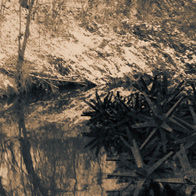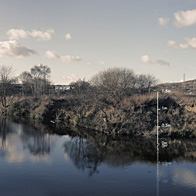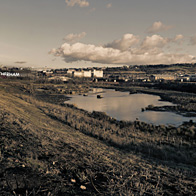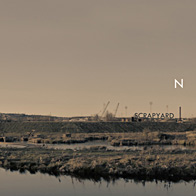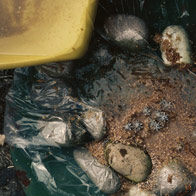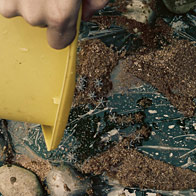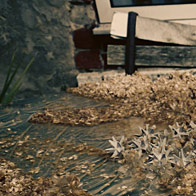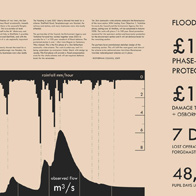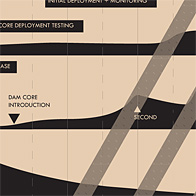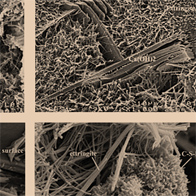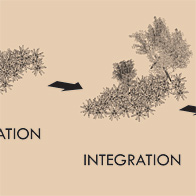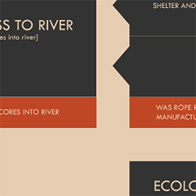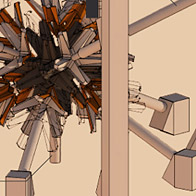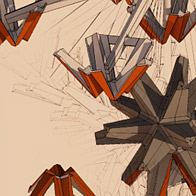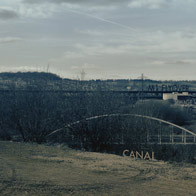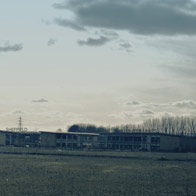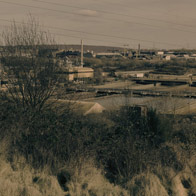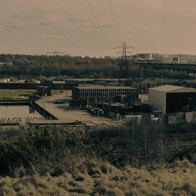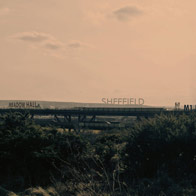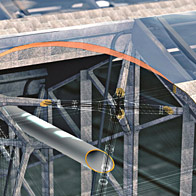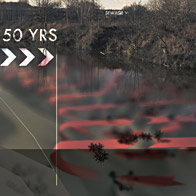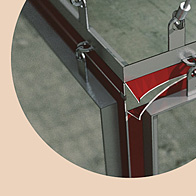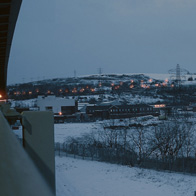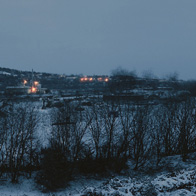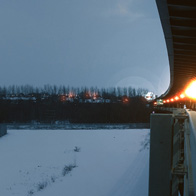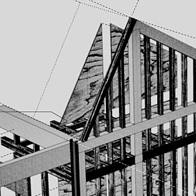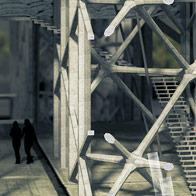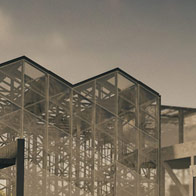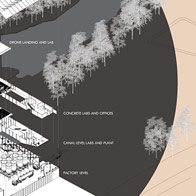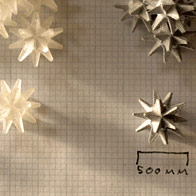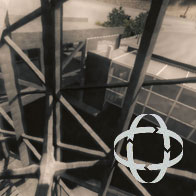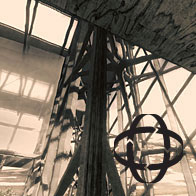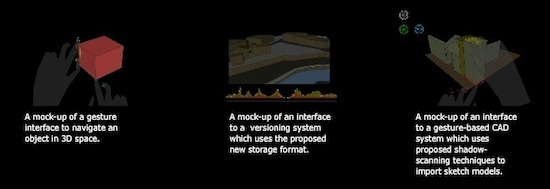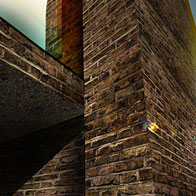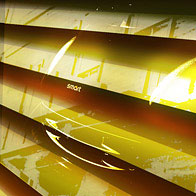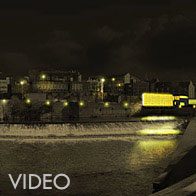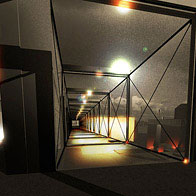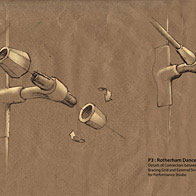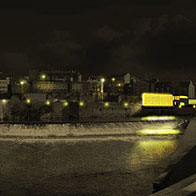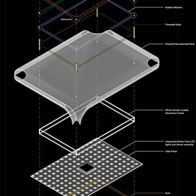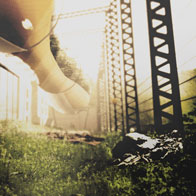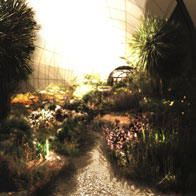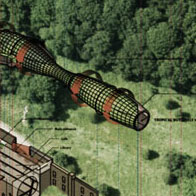Ben Oram's Portfolio. Welcome to my Portfolio of Architecture, Photography and Graphics.
Contact details are at the bottom of the page
Sixth Year / Studio Ten / Meshworks
Studio Ten will begin with two ingredients; a methodology and a site. Both are too broad to remain useful for long, but their interaction will determine the studio's clearer brief. The methodology borrows from Manuel De Landa's discussion of meshworks; the site is the River Don, its valley or hinterland.
De Landa's meshworks set out an interesting approach to analysing cultural structures, urban history and change. It is not a design tool, but its potential for informing design will be explored and developed by the studio.
The Project
My project is to form a flood plane in the Don valley to prevent flooding closer to town.
The parts are made of a biological concrete that's about 25% heavier than water and degrades after three years. The idea is that you release them into a river upstream when you want to create a flood plane. You stretch nets where you want a dam They begin to clog it and become filled with silt and plant matter. Eventually they form banks, diverting the course of the river and creating a large flood plane.
An Automatic Landscape / Design Report
An Automatic Landscape / Technology Report
+ Notes, Links and References...
Links / Research
http://en.wikipedia.org/wiki/Self-organization
http://en.wikipedia.org/wiki/Self-assembly
http://en.wikipedia.org/wiki/Spontaneous_symmetry_breaking
Self-assembling solar arrays as easy as mixing oil and water
Researchers modify tiny solar "chiplets" to get them to self-assemble, driven by the free energy of their interactions with an oil-water interface.
References
Amisah and Cowx Impacts of abandoned mine and industrial discharges on fish abundance andmacro invertebrate diversity of the upper River Don in South Yorkshire
Amisah, S. & COWX, I. G. (2000). Impacts of abandoned mine and industrial discharges on fish abundance and macroinvertebrate diversity of the upper River Don in South Yorkshire, UK. Journal of Freshwater Ecology 15, 237-250.
Faulkner and Wass. Flood estimation by continuous simulation in the don catchment, South Yorkshire, UK. Journal of the Chartered Institution of Water and Environmental Management (2005) vol. 19 (2) pp. 78-84
Kay. Are Ecosystems Structured from the Top-Down or Bottom-Up: A New Look at an Old Debate. Wildlife Society Bulletin (1998) vol. 26 (3) pp. 484-498
Hodkinson. Energy Flow and Organic Matter Decomposition in an Abandoned Beaver Pond Ecosystem. Oecologia (1975) vol. 21 (2) pp. 131-139
Hartman. Long-Term Population Development of a Reintroduced Beaver (Castor fiber) Population in Sweden. Conservation Biology (1994) vol. 8 (3) pp. 713-717
Driscoll et al. The Chemistry and Transport of Mercury in a Small Wetland in the Adirondack Region of New York, USA. Biogeochemistry (1998) vol. 40 (2/3) pp. 137-146
Belovsky. Summer Diet Optimization by Beaver. American Midland Naturalist (1984) vol. 111 (2) pp. 209-222
Martin. Movements and Activities of the Mountain Beaver (Aplodontia rufa). Journal of Mammalogy (1971) vol. 52 (4) pp. 717-723
Mitchell and Niering. Vegetation Change in a Topogenic Bog Following Beaver Flooding. Bulletin of the Torrey Botanical Club (1993) vol. 120 (2) pp. 136-147
Broschart et al. Predicting Beaver Colony Density in Boreal Landscapes. The Journal of Wildlife Management (1989) vol. 53 (4) pp. 929-934
Naiman and Melillo. Nitrogen Budget of a Subarctic Stream Altered by Beaver (Castor canadensis). Oecologia (1984) vol. 62 (2) pp. 150-155
Wagner and Nolte. Evaluation of Hot Sauce® as a Repellent for Forest Mammals. Wildlife Society Bulletin (2000) vol. 28 (1) pp. 76-83
Cook. History of a Beaver Colony. Journal of Mammalogy (1943) vol. 24 (1) pp. 12-18
Schlosser. Dispersal, Boundary Processes, and Trophic-Level Interactions in Streams Adjacent to Beaver Ponds. Ecology (1995) vol. 76 (3) pp. 908-925
Naiman et al. Beaver Population Fluctuations and Tropospheric Methane Emissions in Boreal Wetlands. Biogeochemistry (1991) vol. 12 (1) pp. 1-15
Aldous. Beaver Food Utilization Studies. The Journal of Wildlife Management (1938) vol. 2 (4) pp. 215-222
Johnston and Naiman. Aquatic Patch Creation in Relation to Beaver Population Trends. Ecology (1990) vol. 71 (4) pp. 1617-1621
Naiman et al. Beaver Influences on the Long-Term Biogeochemical Characteristics of Boreal Forest Drainage Networks. Ecology (1994) vol. 75 (4) pp. 905-921
Wright et al. An Ecosystem Engineer, the Beaver, Increases Species Richness at the Landscape Scale. Oecologia (2002) vol. 132 (1) pp. 96-101
Question: Does technology impose its own political or ideological effect on architecture,
independent of the will of the designer? If so, how, and to what extent? This dissertation is based upon three premises:
1. That architecture as a discipline within society must use technology to implement its aims.
2. That these aims are diverted by the technology used to implement them.
3. That these diversions of intent are often politically affecting.
The House, like the government has evolved through a series of coincidences and accidents, only rarely with purpose.This last year has seen the government of this country in crisis, from the near collapse of our financial system to the finances of our political representatives, to our environment. A meltdown must be near.
How could the political system change to fix this crisis? One system that seems to be at the centre of the problem is our system of representation, specifically our voting system.
“The majoritarian or Westminster model - Lijphart uses the terms interchangeably - emphasises certain core values or principles: concentration of power in one-party executives, executive dominance, a two-party system, disproportional electoral systems, centralized government, constitutional flexibility and stability between elections. This meta-constitutional orientation is, at its foundation, therefore highly elitist, based to some extent on mass exclusion and has little emphasis on public participation.” (Flinders and Curry: 2007, p5)
If our system of voting and representation is broken, if it does not allow us to choose the best candidates and remove the worst then how can we have worthy government?
This project will examine the effects that a new voting system might have on the House of Commons. How would the Chamber have to change to accommodate this new political balance?
+ More information...
References
Arendt, Hannah. On Revolution. Jan 1990: 350.
Ballantyne, Andrew. Deleuze and Guattari for Architects, Jan 2007: 124
Bogdanor, Vernon, PR Myths: The facts and the fiction on Proportional Representation, London: The Electoral Reform Society, 2009
Davidoff, Paul. 'Advocacy And Pluralism In Planning.' Journal of the American Planning Association 31, no. 4 (Nov 1965): 331-338.
Dunleavy, P, H Margetts, and S Weir. 'Electoral Reform.' democraticaudit.com.
Fletcher, Max. 'Harriet Martineau and Ayn Rand: Economics in the Guise of Fiction.' American Journal of Economics and Sociology, Oct 1974: 367-379.
Flinders, Matthew, and Dion Curry. 'Bi-constitutionality: Unravelling New Labour's Constitutional Orientations.' Parliamentary Affairs (Hansard Soc), Oct 2007: gsm048v1.
Foote, Kenneth, Attila Tóth, and Anett Árvay. 'Hungary after 1989: Inscribing a New Past on Place.' Geographical Review, Jul 2000: 301-334.
Gladstein, Mimi. 'Ayn Rand and Feminism: An Unlikely Alliance.' College English, Feb 1978: 680-685.
Gonzalez-Velez, Horacio. 'A Computer Simulator for Proportional Representation Systems.' Social Science Computer Review 17, no. 4 (Nov 1999): 435.
Gottdiener, M. 'A Marx for Our Time: Henri Lefebvre and the Production of Space.' Sociological Theory, Mar 1993: 129-134.
Grossman, Elizabeth. 'Review: A Place for Everyone.' The Women's Review of Books, Nov 1995: 24-25.
Harries, Karsten. 'In Response on Reading Structure through the Frame.' Perspecta, Jan 2000: 81.
Heidegger, Martin, : Basic Writings, ed. David Farrell Krell, trans. William Lovitt, New York: Harper & Row, 1977.
Heintges, Robert. 'In Response on an Integral Approach to Structure and Architecture.' Perspecta, Jan 2000: 81.
Holland, Eugene. 'The Anti-Oedipus: Postmodernism in Theory; Or, the Post-Lacanian Historical Contextualization of Psychoanalysis.' Boundary 2, Jan 1986: 291-307.
Jones, Lindsay. 'The Hermeneutics of Sacred Architecture: A Reassessment of the Similtude between Tula, Hidalgo and Chichen Itza, Yucatan, Part I.' History of Religions, Feb 1993: 207-232.
Katyal, Neal. 'Architecture as Crime Control.' Yale Law Journal, Mar 2002: 1039-1139.
Kohn, Margaret. 'The Power of Place: The House of the People as Counterpublic.' Polity, Jul 2001: 503-526.
Krieger, Leonard. 'The Historical Hannah Arendt.' The Journal of Modern History, Dec 1976: 672-684.
May, Todd. 'The Politics of Life in the Thought of Gilles Deleuze.' SubStance, Jan 1991: 24-35.
Mayer, Robert. 'Hannah Arendt, Leninism, the Disappearance of Authority.' Polity, Apr 1992: 399-416.
Mayer, Robert. 'Hannah Arendt, National Socialism and the Project of Foundation.' The Review of Politics, Jul 1991: 469-487.
Nelson, John. 'Politics and Truth: Arendt's Problematic.' American Journal of Political Science, May 1978: 270-301.
Newman, Saul. 'The Place of Power in Political Discourse.' International Political Science Review / Revue internationale de science politique, Apr 2004: 139-157.
Perry, Petra. 'Deleuze's Nietzsche.' Boundary 2, Apr 1993: 174-191.
Popescu, Carmen. 'Review: [untitled].' The Journal of the Society of Architectural Historians 59, no. 3 (Sep 2000): 403-405.
Rosen, Deborah. 'American Nonfiction: Dreams and Nightmares.' English Journal, Sep 1977: 54-55.
Ross, Kristin, and Henri Lefebvre. 'Lefebvre on the Situationists: An Interview.' October, Jan 1997: 69-83.
Sams, Gregory, Uncommon Sense: State is Out of Date, London: Chaos Works, 1998
Schleier, Merrill. 'Ayn Rand and King Vidor's Film 'The Fountainhead': Architectural Modernism, the Gendered Body, and Political Ideology.' The Journal of the Society of Architectural Historians, Sep 2002: 310-331.
Scott, Joanna. 'A Detour through Pietism': Hannah Arendt on St. Augustine's Philosophy of Freedom.' Polity, Apr 1988: 394-425.
Segrest, Robert. 'The Perimeter Projects: The Architecture of the Excluded Middle.' Perspecta, Jan 1987: 54-65.
Shellman, S. 'Active Learning in Comparative Politics: A Mock German Election and Coalition-Formation Simulation.' PS: Political Science and Politics, Jan 2002.
Silman, Robert, 'Is Preservation Technology Neutral?' APT Bulletin, Springfield: Association for Preservation Technology International, Vol. 38, No. 4 (2007), pp. 3-10
Sitton, John. 'Hannah Arendt's Argument for Council Democracy.' Polity, Oct 1987: 80-100.
Snow, C. 'The Two Cultures.' Leonardo, Jan 1990: 169-173.
Steinberger, Peter. 'Hannah Arendt on Judgment.' American Journal of Political Science, Aug 1990: 803-821.
Stivale, Charles. 'Deleuze/Parnet in 'Dialogues': The Folds of Post-Identity'.' The Journal of the Midwest Modern Language Association, Apr 2003: 25-37.
Tsao, Roy. 'Arendt and the Modern State: Variations on Hegel in 'The Origins of Totalitarianism'.' The Review of Politics, Jan 2004: 105-136.
Tyng, Anne. 'In Response on Topology and Organicism in the Work of Louis I. Kahn.' Perspecta, Jan 2000: 81.
Unwin, Tim. 'A Waste of Space? Towards a Critique of the Social Production of Space...' Transactions of the Institute of British Geographers, Jan 2000: 11-29.
Vigne, Eric. 'Inclassable Hannah Arendt.' Vingtieme siecle. Revue d'histoire, Oct 1984: 137-140.
Whitmeyer, J. 'Mann's Theory of Power - A (Sympathetic) Critique.' British Journal of Sociology, Jun 1997: 210-225.
Wilt, Judith. 'On Atlas Shrugged.' College English, Nov 1978: 333-336.
Undergraduate Dissertation / Fluidity in the Digital Design Process (2006)
How can design systems improve our design process? Can they be expected to take a more prevalent role in the architectural process? Where and why do they hinder our process and how can they be improved? What is an ideal concept system?In order to begin this investigation it is important to consider why we as architects made the change from building directly ‘on- site’ and moved into the realm of paper, and then electronic media. More importantly we should acknowledge what is lost in the transition as well as the benefits. There are three areas I propose for investigation.
1. The journey from the real to the abstract: From stone to paper and the journey from paper to electronic.
2. The preservation of information through the design process.
3. From 3D to virtual (the future?).
